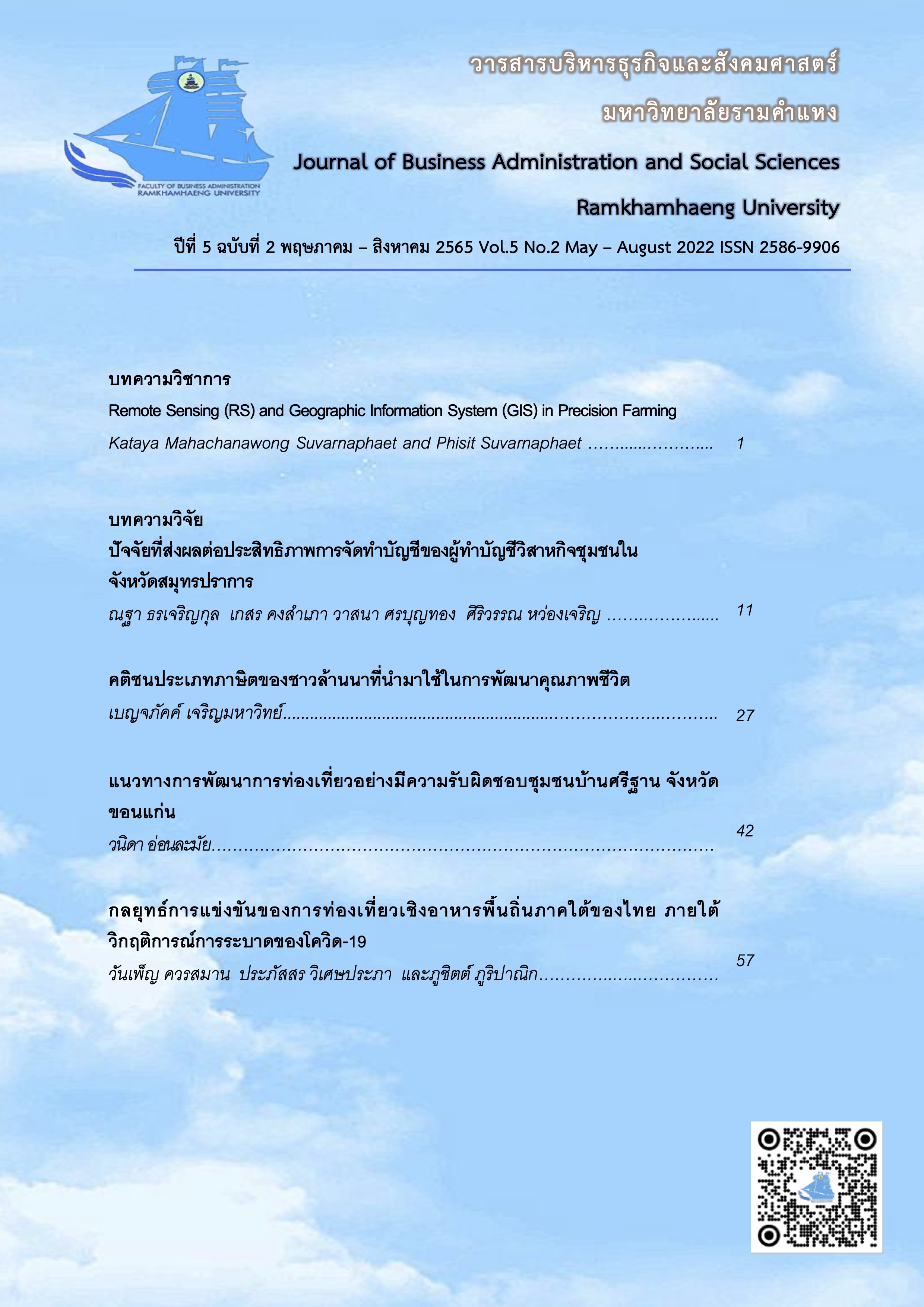Competitive Strategies of Local Gastronomy Tourism in Southern Thailand Under the COVID-19 Pandemic
Main Article Content
Abstract
In this research investigation, the researchers analyze the strengths, weaknesses, opportunities, and obstacles of the local gastronomy tourism in Southern Thailand under the COVID-19 pandemic. The researchers also propose competitive strategies for the local gastronomy tourism under study through the TOWS Matrix process. The technique of mixed-methods research approach was employed using the technique of semi-structured in-depth interview with tour operators in the three southern provinces. Data obtained were developed into a questionnaire eliciting the strengths, weaknesses, opportunities, and obstacles of the local gastronomy tourism under investigation. The questionnaire was conducted with 400 Malaysian and Singaporean tourists visiting Southern Thailand. Factors were analyzed to determine their weight. Data were analyzed using SWOT analysis to determine strategies to foster the survival of the local gastronomy tourism in Southern Thailand through the process of the TOWS Matrix. Four alternative strategies were found as follows: approach strategy; remedial strategy; defensive strategy; and passive strategy. Those involved in the local gastronomy tourism in Southern Thailand can adapt these strategies to be used in accordance with their context.
Article Details

This work is licensed under a Creative Commons Attribution-NonCommercial-NoDerivatives 4.0 International License.
เนื้อหาและข้อมูลในบทความที่ลงตีพิมพ์ในวารสารบริหารธุรกิจและสังคมศาสตร์ มหาวิทยาลัยรามคำแหง ถือเป็นข้อคิดเห็นและความรับผิดชอบของผู้เขียนบทความโดยตรง ซึ่งกองบรรณาธิการไม่จำเป็นต้องเห็นด้วย หรือร่วมรับผิดชอบใดๆ
บทความ ข้อมูล เนื้อหา รูปภาพ ฯลฯ ที่ได้รับการตีพิมพ์ในวารสารบริหารธุรกิจและสังคมศาสตร์ มหาวิทยาลัยรามคำแหง ถือเป็นลิขสิทธิ์ของวารสารบริหารธุรกิจและสังคมศาสตร์ มหาวิทยาลัยรามคำแหง หากบุคคลหรือหน่วยงานใดต้องการนำบทความทั้งหมดหรือส่วนหนึ่งส่วนใดไปเผยแพร่ต่อ หรือเพื่อกระทำการใดๆ จะต้องได้รับอนุญาตเป็นลายลักษณ์อักษรจากวารสารบริหารธุรกิจและสังคมศาสตร์ มหาวิทยาลัยรามคำแหง ก่อนเท่านั้น
References
กระทรวงการท่องเที่ยวและกีฬา. (2562). สถิตินักท่องเที่ยวภายในประเทศ Q1-Q4 ปี 2562 (ภาคใต้). สืบค้นจาก https://www.mots.go.th/News-view.php?nid=11908
กรุงเทพธุรกิจ. (2563). ททท. ชวนคนไทยอิ่มฟินกับ ‘ล่องกินถิ่นใต้. สืบค้นจาก https://www.bangkokbiz news.com/lifestyle/895099
คณะกรรมการนโยบายการท่องเที่ยวแห่งชาติ. (2560). แผนพัฒนาการท่องเที่ยวแห่งชาติ ฉบับที่ 2 (พ.ศ. 2560 – 2564). กรุงเทพฯ: สำนักงานกิจการโรงพิมพ์องค์การสงเคราะห์ทหารผ่านศึกษา.
เชียงใหม่นิวส์. (2560). ดันเมืองไทย ขึ้นแท่น”ฮับ” เที่ยวเชิงอาหาร. สืบค้นจาก https://www.chiangmai news.co.th/page/archives/616781/
พิบูล ทีปะปาล. (2551). การจัดการเชิงกลยุทธ์ = Strategic management. กรุงเทพฯ: อมรการพิมพ์.
มติชนออนไลน์. (2564). โควิดกระทบ! โรงแรมภาคใต้ ปิดให้บริการ 90% นักท่องเที่ยวหาย ยอดเข้าพัก พ.ค.เหลือ1%. สืบค้นจาก https://www.matichon.co.th /economy/news_2742023
วันเพ็ญ ควรสมาน และภูชิตต์ ภูริปาณิก. (2564). การศึกษาเปรียบเทียบศักยภาพการท่องเที่ยวเชิงอาหารพื้นถิ่นภาคใต้ มาเลเซียและสิงคโปร์ และการพัฒนาระบบข้อมูลทางการตลาดสำหรับผู้ประกอบการนำเที่ยว. หน่วยบริหารและจัดการทุนด้านการเพิ่มความสามารถในการแข่งขันของประเทศ (บพข.)
สุชาติ ประสิทธิ์รัฐสินธุ์, กรรณิการ์ สุขเกษมม โศภิต ผ่องเสรี, และถนอมรัตน์ ประสิทธิเมตต์. (2551). แบบจำลองสมการโครงสร้าง การใช้โปรแกรม LISREL, PRELIS และ SIMPLIS (เทคนิคการวิเคราะห์เชิงปริมาณที่กำลังเป็นที่นิยมกันมาก). กรุงเทพมหานคร: ห้างหุ้นส่วนจำกัดสามลดา.
สุรพงษ์ โสธนะเสถียร. (2533). การสื่อสารกับสังคม. กรุงเทพฯ : โรงพิมพ์จุฬาลงกรณ์มหาวิทยาลัย.
วุฒิชัย กฤษณะประกรกิจ. (2560). Foodie Food Tourism Trend 2017. Retrieved from http://etatjournal .com/web/menu-read-tat/menu-2017/menu-12017/756-12017-foodie
องค์การบริหารการพัฒนาพื้นที่พิเศษเพื่อการท่องเที่ยวอย่างยั่งยืน (องค์การ มหาชน). (2559). ใส่ใจไปเที่ยวกับ อพท. การท่องเที่ยวเชิงอาหาร. กรุงเทพฯ: บริษัท โคคูน แอนด์ โค จำกัด.
Adi, I. N. R., Utama, M. S., Budhi, M. K. S., & Purbadharmaja, I. B. P. (2017). The role of government in community based tourism and sustainable tourism development at Penglipuran Traditional Village—Bali. IOSR Journal of Humanities and Social Science 22(6), 15-20.
Assaker, G. (2014). Examining a hierarchical model of Australia’s destination image. Journal of Vacation Marketing, 20(3), 195-210.
Florek, M. (2005). The country brand as a new challenge for Poland. Place branding, 1(2), 205-214.
Hanafiah, M. H., Jamaluddin, M. R., & Zulkifly, M. I. (2013). Local community attitude and support towards tourism development in Tioman Island, Malaysia. Procedia-Social and Behavioral Sciences, 105, 792-800.
Humphrey, A. S. (2005). SWOT analysis. Long Range Planning, 30(1), 46-52.
Kock, F., Josiassen, A., & Assaf, A. G. (2016). Advancing destination image: The destination content model. Annals of tourism research, 61, 28-44.
Martín-Santana, J. D., Beerli-Palacio, A., & Nazzareno, P. A. (2017). Antecedents and consequences of destination image gap. Annals of tourism research, 62, 13-25.
Nunnally, J. C. (1978). Psychometric theory (2nd ed.). New York: McGraw-Hill.
Stylidis, D., & Cherifi, B. (2018). Characteristics of destination image: visitors and non-visitors’ images of London. Tourism Review. 73(1), 56-67.
UNWTO. (2017). Second Global Report on Gastronomy Tourism. Retrieved from
https://www.e-unwto.org/doi/pdf/10.18111/9789284418701
Weihrich, H. (1993). Daimler‐Benz′s Move Towards The Next Century with The Tows Matrix. European Business Review, 93(1), 4.
Wheelen, T. L., & Hunger, J. D. (2002). Strategic management and business policy. Upper Saddle River, N.J: Prentice Hall.
Yamane, T. (1967). Statistics, An Introductory Analysis (2nd Ed.), New York: Harper and Row.


